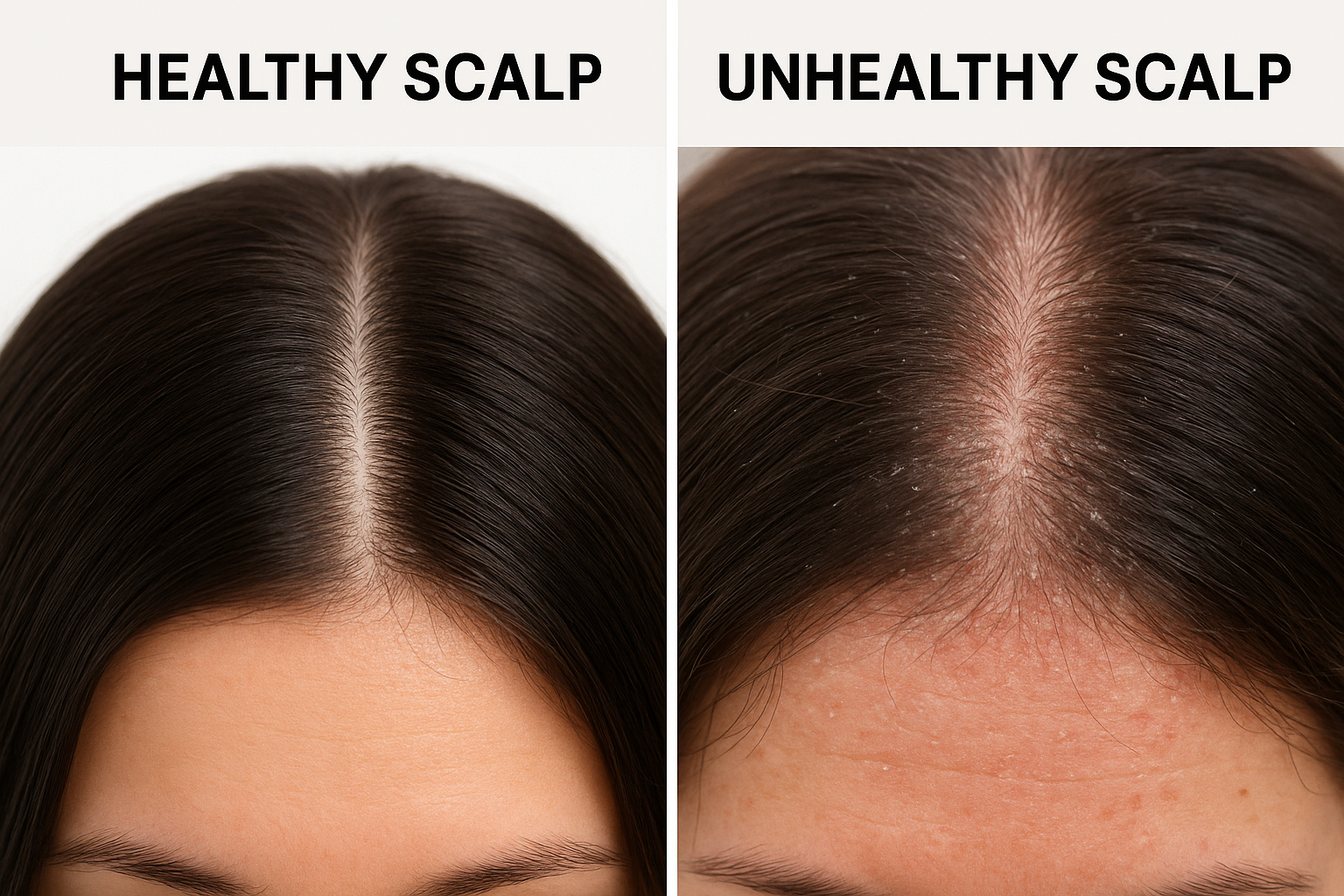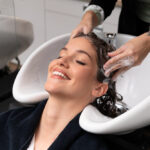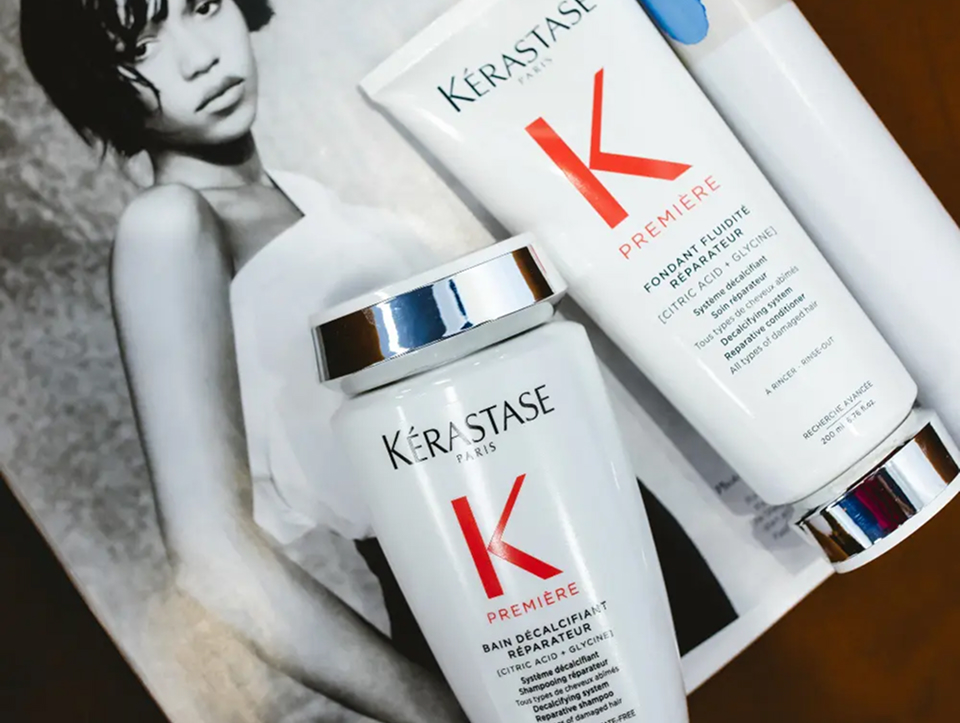You’re here because you searched for ‘healthy scalp vs unhealthy scalp,’ probably after spotting flakes, experiencing itchiness, or wondering if your scalp is as healthy as it should be.
Here’s the tricky part: your scalp doesn’t come with an instruction manual. One day it’s oily, the next day flaky. And let’s be real, nobody teaches us how to care for our scalp.
But what if we say you can quickly decode the signals your scalp sends and know what’s healthy and what’s not?
That’s what we’re here to help do. To quickly identify all scalp signs, maintain a balanced scalp, and know when to consult our professionals at Haste Urban Hair Spa.
Quick Comparison: Healthy Scalp vs Unhealthy Scalp
| Signal | ✅ Healthy Scalp | 🚫 Unhealthy Scalp |
| Look/Color | Even tone, calm | Red patches, greasy yellow scale, or dry white flakes |
| Feel | Comfortable, itch-free | Itchy, tight, burning sores, bumps |
| Oil Level | Balanced—fresh for 1–2 days | Greasy hours after wash OR persistently dry |
| Flakes | None | Dandruff-like flakes or dry shedding |
| Shedding | Typical 50–100 hairs/day | Clumps or a widening part |
| Odor | Neutral | Unpleasant smell from oil/buildup |
| First Steps | Keep a gentle routine | Identify scalp type + start targeted care |
What Is a Healthy Scalp?

A healthy scalp is the cornerstone of strong hair. Key characteristics include:
- Follicle Health: Hair follicles are intact, producing healthy strands
- Color: Pale pink or peach, consistent across the scalp
- Texture: Smooth, without flakes or bumps
- Moisture: Balanced—not too oily or dry
✨ Tip: Add a 1-minute scalp massage while shampooing. It boosts circulation and feels fantastic.
📚 Research: A metagenomic study of the Indian scalp microbiome found that healthy scalps were enriched with bacterial pathways involved in synthesizing amino acids, biotin, and B-vitamins—key nutrients that support scalp health and hair growth.
Notably, applying coconut oil increased beneficial bacteria, such as Cutibacterium acnes, which correlated with an improved scalp condition.
Signs of an Unhealthy Scalp
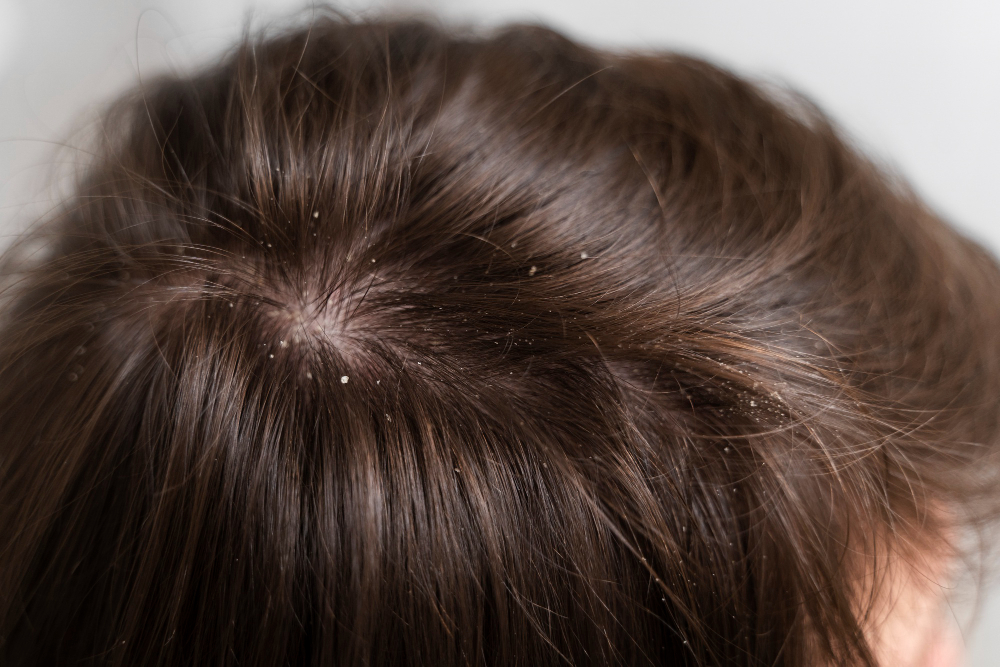
When comparing a healthy scalp to an unhealthy scalp, the signs can vary depending on the underlying cause. Here are some signs:
- Red or Pink Patches: Often indicate irritation or inflammation
- Dry, Flaky Skin: May result from dandruff, eczema, or psoriasis
- Excess Oiliness: Can clog follicles and cause scalp acne or folliculitis
- Unusual Odor: May suggest fungal infections
- Hair Shedding: Thinning hair linked to scalp health issues
🧴 Tip: Don’t ignore these signs. The longer you wait, the more stubborn scalp imbalances can become, sometimes leading to increased shedding or, in severe cases, scarring.
💡 Did you know? Stress hormones, such as cortisol, can exacerbate inflammation and oil production, leading to scalp issues flaring up more quickly. Learn more here: Stress and Scalp Health.
📚 Research: Stress can directly harm hair/scalp biology. A 2021 study in Nature showed that chronic stress hormones (corticosterone in mice) suppress a dermal-niche factor called GAS6, which maintains hair-follicle stem cells in a resting state. This mechanism explains how chronic stress can cause hair thinning and exacerbate scalp issues.
📝 60-Second Self-Check Quiz
👉 Answer honestly. Each “yes” = 1 point.
Questions:
- Do you scratch your scalp daily?
- Do flakes show up on clothes or pillows?
- Is your scalp tender or sore?
- Does it get greasy within hours?
- Does it still smell off even after washing?
- Are you shedding more than usual?
Results
- 0–1 yes → Your scalp’s looking pretty healthy. Maintain a gentle routine and try the scalp-care tips.
- 2–3 yes → Early warning signs. It’s time to tweak your routine and watch for improvement (see ‘Maintain Scalp Health’).
- 4+ yes → Your scalp needs attention ASAP. Book a professional scalp treatment or consult a dermatologist for expert advice.
Healthy Scalp vs Unhealthy Scalp: Causes and Risk Factors
Your scalp is delicate, and several things can throw it off balance:
Internal Factors

- Stress: Stress hormones (like cortisol) spike inflammation and oil production. Chronic stress can inhibit hair follicle activity, resulting in hair thinning.
- Nutrition: Diets low in antioxidants, vitamins, and omega-3 fatty acids can weaken the scalp barrier, increasing its susceptibility to irritation.
- Hormonal Changes: Fluctuations from puberty, pregnancy, menopause, or thyroid imbalance can alter oil levels and sensitivity.
External Factors

- Overwashing: Harsh cleansers strip away protective oils, leaving the scalp tight and itchy.
- Product Buildup: Heavy styling creams, oils, and dry shampoos can clog follicles, leading to unpleasant odors. Read more here: Oily Hair or Oily Scalp.
- Environment: Sun, pollution, and hard water all irritate the scalp and contribute to flaking.
- Heat Styling: Excessive blow-drying or straightening can weaken the scalp barrier and cause dehydration.
Medical Conditions
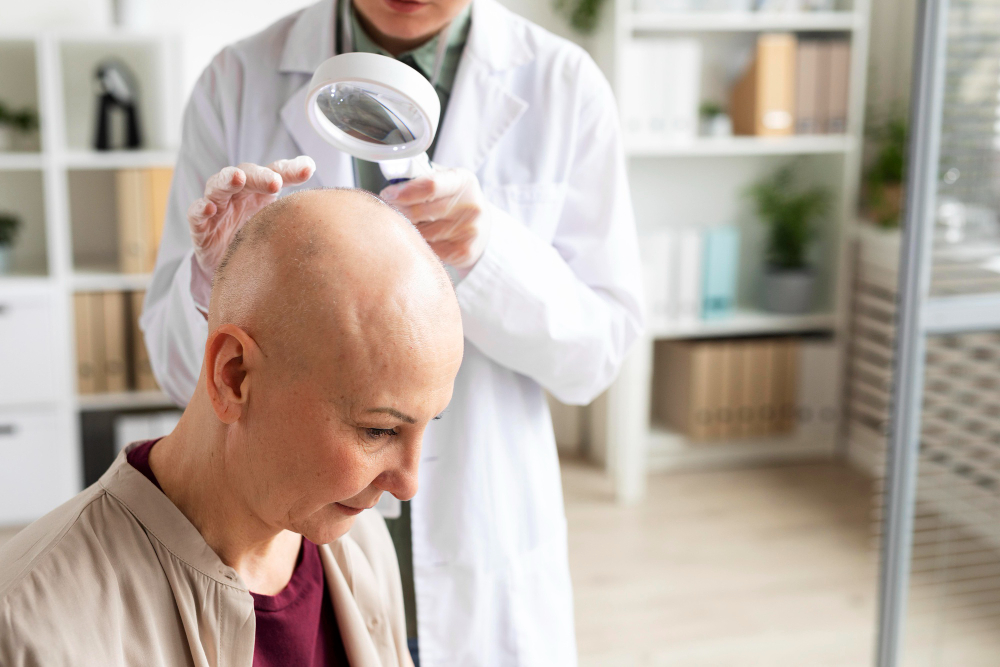
Sometimes it’s not just lifestyle:
- Seborrheic Dermatitis (oily dandruff with yellow flakes)
- Psoriasis (thick, scaly plaques that can bleed)
- Eczema (itchy, red, patchy skin)
- Folliculitis (infected, painful bumps)
👉 Curious? Learn more at Common Scalp Conditions and Hair Loss Related to Sugar
Scalp Color Guide
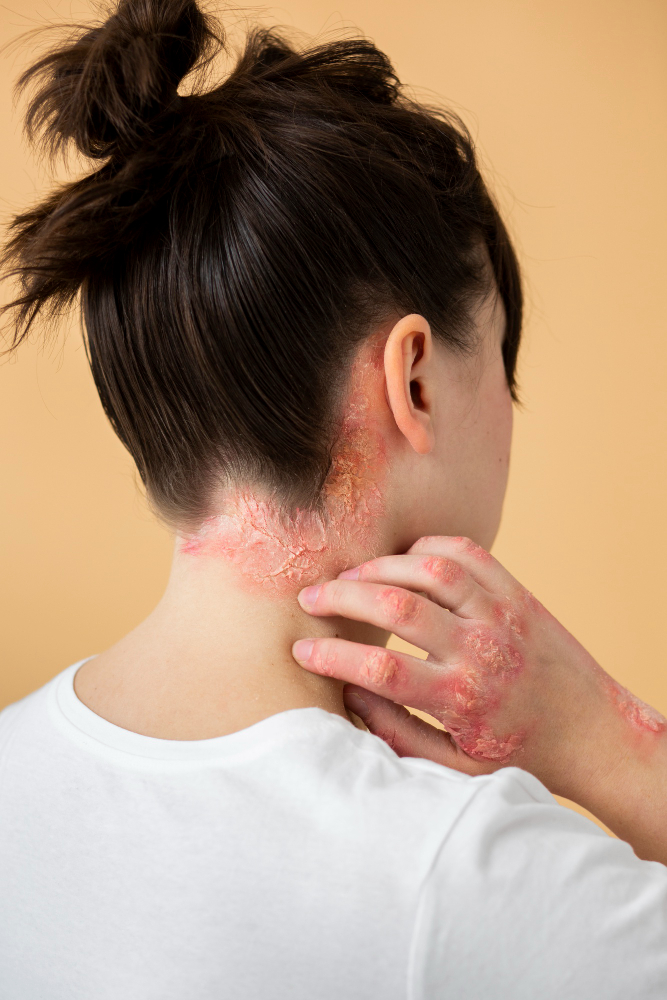
Understanding your scalp color can help identify issues:
| Scalp Color | Possible Cause | Suggested Action |
|---|---|---|
| Pale Pink / Peach | Healthy scalp | Maintain care routine |
| Red / Pink | Irritation, inflammation, sunburn | Use gentle care, consult professional if persistent |
| White / Flaky | Dry scalp, dandruff, fungal infection | Hydrate, exfoliate, use anti-dandruff treatments |
Healthy Scalp vs Unhealthy Scalp: Fixes by Scalp Type
Your scalp is unique, so solutions need to match your type. Here’s how to take action:
Oily / Dandruff-Prone Scalp

What’s happening: Sebum + Malassezia yeast overgrowth → flakes, itch, odor.
What helps:
- Wash 3–5 times weekly with medicated or balancing shampoos (look for ingredients such as zinc pyrithione, selenium sulfide, or ketoconazole).
- Avoid heavy oils that “feed” yeast.
- Rinse thoroughly—residue fuels buildup.
✨ Tip: Rotate anti-dandruff shampoos (switch actives every few weeks) so yeast doesn’t adapt.
Dry / Flaky Scalp (Non-dandruff)
What’s happening: Stripped barrier + lack of moisture.
What helps:
- Switch to sulfate-free shampoos.
- Add hydrating conditioners or leave-ins (look for glycerin, aloe, or ceramides).
- Try a weekly low-% AHA/BHA scalp exfoliant to loosen dead cells without harsh scrubbing.
- Use a humidifier in dry seasons.
✨ Tip: Massage a few drops of lightweight jojoba oil before bed once a week—it mimics the scalp’s natural sebum.
Sensitive / Irritated Scalp
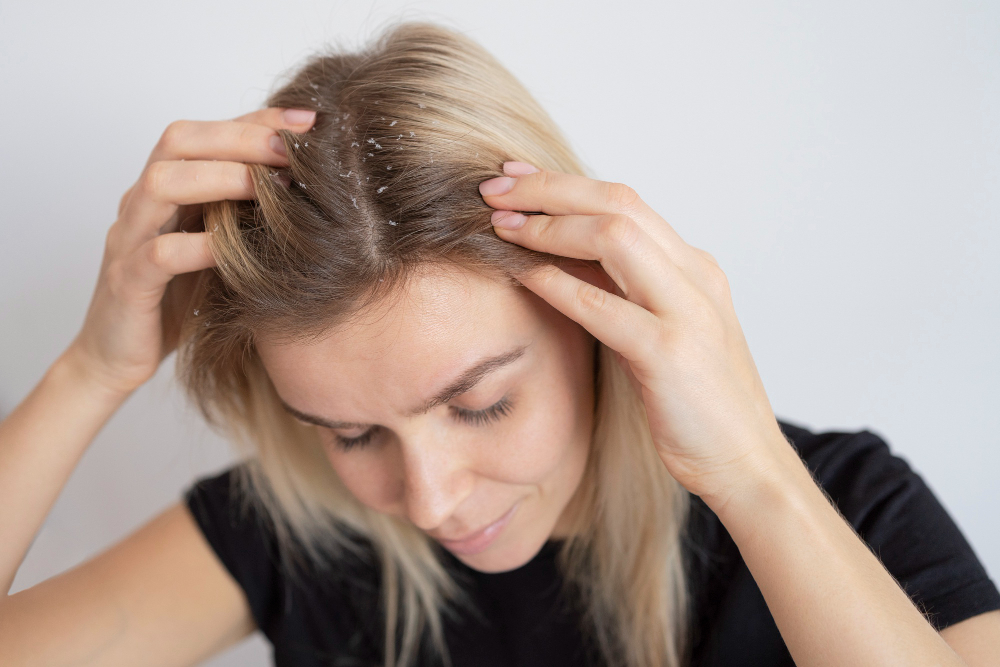
What’s happening: Inflamed or reactive skin barrier.
What helps:
- Use fragrance-free, hypoallergenic shampoos.
- Wash with lukewarm—not hot—water.
- Patch-test new products on a small area behind the ear before applying them to the rest of the body.
- Reduce styling heat and avoid scratching.
✨ Tip: Store your scalp serum in the fridge. The cooling sensation soothes irritation instantly.
Buildup / Residue Scalp
What’s happening: Layers of product, minerals, or sebum suffocate follicles.
What helps:
- Use a clarifying shampoo weekly.
- Try a chelating rinse (with EDTA or apple cider vinegar) after swimming or if you live in a hard-water area.
- Rebalance with a hydrating conditioner afterward.
✨ Tip: If you use lots of styling products, schedule a professional deep cleanse once a month.
Matching your scalp type to the proper treatment prevents trial-and-error frustration and helps you recover faster.
Scalp Care Tools & Lifestyle Tips
| Category | What It Does / Tips |
| Scalp Massagers | Boost circulation, reduce tension and stress |
| Scalp Scrubs | Remove buildup, exfoliate dead skin; limit to once a week |
| Oils | Nourishing if lightweight (jojoba, argan); avoid heavy oils that clog follicles |
| Omega-3s | Support scalp barrier & reduce inflammation; eat fish, flaxseed, walnuts |
| Antioxidants | Protect scalp from oxidative stress; berries, leafy greens, nuts |
| Hydration | Keep scalp cells healthy; drink water & herbal teas |
| Stress Relief | Reduce flare-ups and scalp inflammation; sleep well, yoga, walking |
💡 Tip: Your scalp reflects your daily habits—combine gentle tools with a balanced diet and effective stress management for optimal results.
👉 Learn more about diet & scalp health here: How Your Diet Affects Scalp Health
Professional Help, Key Ingredients & Common Myths
| Category | Details / Tips |
| When to See a Professional | Painful sores, bleeding, oozing, sudden hair loss, or persistent irritation. Early intervention prevents worsening issues. |
| Spa Option | Prefer a holistic approach first? Schedule a professional scalp treatment at Haste Urban Hair Spa. |
| Zinc Pyrithione & Ketoconazole | Anti-dandruff and itch relief; helps control yeast overgrowth |
| Urea & Ceramides | Repair and hydrate the scalp barrier; soothe dryness |
| Salicylic Acid | Gentle exfoliation for buildup and flakiness |
| SPF Spray | Protects scalp from UV damage, especially along part lines |
| Myth: “Dandruff = dry scalp” | False — it’s often oily + fungus-related |
| Myth: “Daily washing is bad.” | Depends on your scalp type — some need daily cleansing |
| Myth: “Redness after styling is normal.” | Persistent redness isn’t normal; monitor for irritation. |
💡 Tip: Understanding when to seek professional care and which ingredients help keep your scalp balanced and prevent guesswork.
Ready for a Happier, Healthier Scalp?
Now you know the difference between a healthy scalp and an unhealthy scalp, plus how to get yours back in balance.
Whether you’re dealing with dryness, oil, flakes, or want to pamper your scalp, you don’t have to do it alone.
👉 Book your personalized scalp treatment today at Haste Urban Hair Spa and let the experts bring your scalp back to life.
FAQ
What color is a healthy scalp?
A healthy scalp should match your natural skin tone with no redness, irritation, or discoloration. If you notice persistent pink, red, or dark patches, it could signal inflammation or an underlying condition that needs attention.
Can scalp issues cause hair loss?
Yes, chronic scalp problems, such as inflammation, infection, or severe dandruff, can damage hair follicles over time. Early care—including proper cleansing, hydration, and professional treatment- usually prevents permanent hair loss.
How do I exfoliate safely?
Use gentle scalp exfoliants, such as low-percentage alpha-hydroxy acids (AHA) or beta-hydroxy acids (BHA), once a week. Always follow with a nourishing conditioner or treatment to maintain the scalp barrier and prevent irritation.
How often should I clarify my scalp?
Generally, once a week or every two weeks is sufficient, depending on your oil levels, styling products, and water type. Over-clarifying can strip natural oils, so always follow with a hydrating conditioner or serum to replenish moisture.
What is the ideal shampoo pH?
A: Shampoos with a pH around 4.5–5.5 are slightly acidic, matching your scalp’s natural environment. This helps maintain the barrier, prevent dryness or irritation, and keep your hair cuticles smooth and healthy.
Why is my scalp pink or red?
Pink or red scalp may result from irritation, inflammation, or medical conditions like dermatitis or psoriasis.

